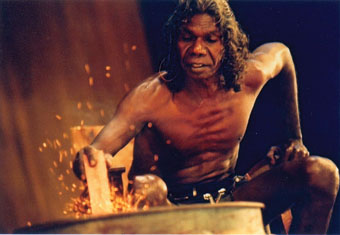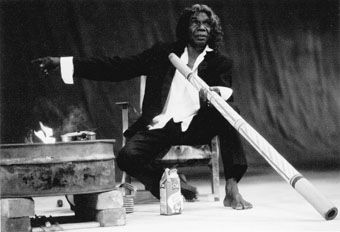Gulpilil
Company B
Dunstan Playhouse, March 1-14
 |
David Gulpilil, Gulpilil photo Mark Rogers |
Gulpilil appears both at ease and restless on the large stage, thinking his way into stories, dropping into silences, regarding us as listeners with the necessary time on our hands— his time. He is not an actor who assumes an automatic contract between performer and audience: addressing us directly, he wants to make that contract, remind us of it, hold us to it with a gentle but firm cajoling. It’s as if in the cavernous space of the Playhouse he has to make sure we’re there. We have to forget our theatre manners and let him know we’re ready to go croc hunting with him, read English for him, recognise his films and share the recollection of his AFI Award speech (“I deserve this”). He wants to hear us. We want to hear him, and see him, a man who always moves like a dancer, long-limbed, graceful, sudden, a hunter sharing with us his respect for the totem of his mother’s clan: the crocodile. His is the dance of the hunter with the tools of his role (spear, woomera, twine) and a crocodile skull he addresses affectionately and playfully.
 |
David Gulpilil, Gulpilil photo Mark Rogers |
Gulpilil is a work rich in detail and observation. There are recollections of the making of Walkabout, of a boy appearing in a lap lap at Buckingham Palace and taking snaps at Cannes (the camera caused a bomb scare). There are personalities and political wit—he ‘phones’ Philip Ruddock at one point suggesting refugees be shown his tin ‘humpy’: “they’ll see how hard it is and they’ll row home.” Gulpilil bemoans the lives of “kids full of white ideas...boredom and kava.” What can he do? Teach and pass on his culture, he tells us. This is all framed in an easy-going theatricality of a broadly chronological telling with a patterning of themes and film excerpts, and simple staging; a chair, table, possessions and a fire against a huge backcloth. The arrival of The Wet, replete with thunder track, lightning and real water in a fine glasshouse spray, is one of the few moments of theatrical excess.
Gulpilil is a big one-man show, at least 2 hours plus an interval. The life may well warrant the duration and the performance our admiration, but, once the work settles, an uninterrupted 90 minute version might be more comfortable for the performer and more focused. Not that audiences thought so: standing ovations were the order of the day and there was the sense that audience and performer were at one. Gulpilil held us to our contract with charisma, skill and stories the like of which we’ve rarely heard.
RealTime issue #60 April-May 2004 pg. 14
© Keith Gallasch; for permission to reproduce apply to [email protected]








 back
back